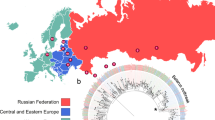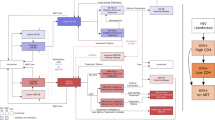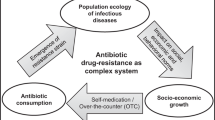Abstract
We use a mathematical model to understand (from 1996 to 2001) and to predict (from 2001 to 2005) the evolution of the epidemic of drug-resistant HIV in San Francisco. We predict the evolutionary trajectories for 1,000 different drug-resistant strains with each strain having a different fitness relative to a drug-sensitive strain. We calculate that the current prevalence of resistance is high, and predict it will continue to rise. In contrast, we calculate that transmission of resistance is currently low, and predict it will remain low. We show that the epidemic of resistance is being generated mainly by the conversion of drug-sensitive cases to drug-resistant cases, and not by the transmission of resistant strains. We also show that transmission of resistant strains has not increased the overall number of new HIV infections. Our results indicate that transmission of resistant strains is, and will remain, a relatively minor public health problem.
This is a preview of subscription content, access via your institution
Access options
Subscribe to this journal
Receive 12 print issues and online access
$209.00 per year
only $17.42 per issue
Buy this article
- Purchase on Springer Link
- Instant access to full article PDF
Prices may be subject to local taxes which are calculated during checkout




Similar content being viewed by others
References
Espinal, M.A. et al. Global trends in resistance to antituberculosis drugs. N. Engl. J. Med. 344, 1294–1303 (2001).
Blower, S.M., Small, P.M. & Hopewell, P.C. Control strategies for tuberculosis epidemics: new models for old problems. Science 273, 497–500 (1996).
Blower, S.M. & Gerberding J.L.G., Understanding, predicting and controlling the emergence of drug-resistant tuberculosis: A theoretical framework. J. Mol. Med. 76, 624–636 (1998).
Blower, S.M., Koelle K. & Lietman, T. Antibiotic resistance—to treat....(or not to treat)? Nature Med. 5, 358–359 (1999).
Blower, S.M., Porco, T.C. & Darby, G. Predicting and preventing the emergence of antiviral drug resistance in HSV-2. Nature Med. 4, 664–665 (1998).
Catania, J.A. et al. Health care policy: U.S. priorities-HIV prevention. Science 290, 717 (2000).
Annual Surveillance Report 2000. San Francisco Department of Public Health HIV Seroepidemiology and Surveillance Section AIDS surveillance Unit. San Francisco Department of Health, San Francisco, California. Also available at http://www.dph.sf.ca.us
Ledergerber, B. et al. AIDS-related opportunistic illnesses occurring after initiation of potent antiretroviral therapy: The Swiss HIV cohort study. JAMA 282, 2220–2226 (1999).
Hogg, R.S. et al. Improved survival among HIV-infected individuals following initiation of antiretroviral therapy. JAMA 279, 50–54 (1998).
Detels, R. et al. Effectiveness of potent antiretroviral therapy on time to AIDS and death in men with known HIV infection duration. Multicenter AIDS Cohort Study Investigators. JAMA 280, 1497–503 (1998).
Palella, F.J. Jr et al. Declining morbidity and mortality among patients with advanced human immunodeficiency virus infection. N. Engl. J. Med. 338, 853–860 (1998).
Hecht F.M. et al. Sexual transmission of an HIV-1 variant resistant to multiple reverse-transcriptase and protease inhibitors. N. Engl. J. Med. 339, 307–311 (1998).
Little, S.J. et al. Reduced antiretroviral drug susceptibility among patients with primary HIV infection. JAMA 282, 1142–1149 (1999).
Solomon H. et al. Prevalence of HIV-1 resistant to antiretroviral drugs in 81 individuals newly infected by sexual contact or injecting drug use. Investigators of the Quebec Primary Infection Study. AIDS 14, F17–23 (2000).
Yerly, S. et al. Transmission of antiretroviral-drug-resistant HIV-1 variants. Lancet 354, 729–733 (1999).
Blower, S.M., Gershengorn, H.B. & Grant, R.M. A tale of two futures: HIV and antiretroviral therapy in San Francisco. Science 287, 650–654 (2000).
CDC. Increases in unsafe sex and rectal gonorrhea among men who have sex with men—San Francisco, California, 1994–1997. Morb. Mortal. Wkly Rep. Surveill. Summ. 48, 45–48 (1998).
CDC. Resurgent bacterial sexually transmitted disease among men who have sex with men—King County, Washington, 1997–1999. MMWR 48, 773–777 (1999).
CDC. Outbreak of syphilis among men who have sex with men—Southern California, 2000. MMWR 50, 117–120 (2001).
Huang, W. et al. Patterns of plasma human immunodeficiency virus type 1 RNA response to antiretroviral therapy. J. Infect. Dis. 183, 1455–1465 (2001).
Hansel, A., Bucher, H.C, Nuesch, R. & Battegay, M.J. Reasons for discontinuation of first highly active antiretroviral therapy in a cohort of protease inhibitor-naive HIV-infected patients. AIDS 26, 191–193 (2001).
Gallant, J.E. Strategies for long-term success in the treatment of HIV infection. JAMA 283, 1329–1334 (2000).
Descamps, D. et al. Mechanisms of virologic failure in previously untreated HIV-infected patients from a trial of induction-maintenance therapy. Trilege (Agence Nationale de Recherches sur le SIDA 072) Study Team). JAMA 283, 205–211 (2000).
Pialoux, G. et al. A randomized trial of three maintenance regimens given after three months of induction therapy with zidovudine, lamivudine, and indinavir in previously untreated HIV-1–infected patients. Trilege (Agence Nationale de Recherches sur le SIDA 072) Study Team. N. Engl. J. Med. 339, 1269–1276 (1998).
Havlir, D.V. et al. Drug susceptibility in HIV infection after viral rebound in patients receiving indinavir-containing regimens. JAMA 283, 229–234 (2000).
Ghani, A.C., Henley W.E., Donnelly, C.A., Mayer S. & Anderson R.M. Comparison of the effectiveness of non-nucleoside reverse transcriptase inhibitor-containing and protease inhibitor-containing regimens using observational databases. AIDS 15, 1133–1142 (2001).
Paredes, R. et al. Predictors of virological success and ensuing failure in HIV-positive patients starting highly active antiretroviral therapy in Europe: Results from the EuroSIDA study. Arch. Intern. Med. 160, 1123–1132 (2000).
Conway, B. et al. Development of drug resistance in patients receiving combinations of zidovudine, didanosine and nevirapine. AIDS 6, 1269–1274 (2001).
Blower, S.M. & Dowlatabadi, H. Sensitivity and uncertainty analysis of complex models of disease transmission: An HIV model, as an example. Internat. Stat. Rev. 2, 229–243 (1994).
Blower, S.M. et al. The intrinsic transmission dynamics of tuberculosis epidemics. Nature Med. 1, 815–821 (1995).
Quinn, T.C. et al. Viral load and heterosexual transmission of HIV-1. N. Engl. J. Med. 342, 921–972 (2000).
Little, S.J. Is transmitted drug resistance in HIV on the rise? Brit. Med. J. 322, 1074–1075 (2001).
Stoddart, C.A. et al. Impaired replication of protease inhibitor-resistant HIV-1 in human thymus. Nature Med. 7, 712–718 (2001).
Gazzard B. & Moyle, G. 1998 Revision to the British HIV Association guidelines for antiretroviral treament of HIV seropositive individuals. BHIVA Guidelines Writing Committee. Lancet 352, 314–316 (1998).
Tchetgen, E., Kaplan, E.H. & Friedland, G.H. Public health consequences of screening patients for adherence to highly active antiretroviral therapy. J. Acquir. Immune Defic. Syndr. 26, 118–129 (2001).
Blower, S.M., Koelle, K., Kirschner, D. & Mills, J. Live attenuated HIV vaccines: Predicting the trade-off between efficacy and safety. Proc. Natl. Acad. Sci. USA 98, 3618–3623 (2001).
Blower S.M. Calculating the consequences: HAART and risky sex. AIDS 15, 1309–1310 (2001).
Iman, R.L. & Helton, J.C. An investigation of uncertainty and sensitivity analysis techniques for computer models. Risk Anal. 8, 71–90 (1988).
Kleijnen, J.P.C. & Helton, J.C. Statistical analyses of scatterplots to identify important factors in large-scale simulations, 1: Review and comparison of techniques. Reliability Engineering and System Safety 65, 147–185 (1999).
Acknowledgements
We thank J. Catania, B. Goldberg, F. Hecht, R. Grant, M. Markowitz, M. McCune P. Volberding and D., J. and N. Freimer for helpful discussions. This study was supported by the NIH/NIAID (Grant No. AI41935 to S.M.B.), the UCSF-GIVI Center for AIDS Research (p30MH59037 to J.O.K.) and the NIH (Grant No. U01A41531 (J. Levy PI)) and University of California-wide AIDS Research program (CC99-SF-001).
Author information
Authors and Affiliations
Corresponding author
Rights and permissions
About this article
Cite this article
Blower, S., Aschenbach, A., Gershengorn, H. et al. Predicting the unpredictable: Transmission of drug-resistant HIV. Nat Med 7, 1016–1020 (2001). https://doi.org/10.1038/nm0901-1016
Received:
Accepted:
Issue Date:
DOI: https://doi.org/10.1038/nm0901-1016
This article is cited by
-
Ecological and evolutionary dynamics of multi-strain RNA viruses
Nature Ecology & Evolution (2022)
-
Two strains and drug adherence: An HIV model in the paradigm of community transmission
Nonlinear Dynamics (2022)
-
Masivukeni: Development of a Multimedia Based Antiretroviral Therapy Adherence Intervention for Counselors and Patients in South Africa
AIDS and Behavior (2013)
-
Directly Observed versus Self-administered Antiretroviral Therapies: Preference of HIV-Positive Jailed Inmates in San Francisco
Journal of Urban Health (2012)
-
Mathematical Analysis of a Model for Assessing the Impact of Antiretroviral Therapy, Voluntary Testing and Condom Use in Curtailing the Spread of HIV
Differential Equations and Dynamical Systems (2011)



